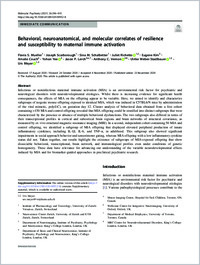Behavioral, neuroanatomical, and molecular correlates of resilience and susceptibility to maternal immune activation.
- Mueller FS Institute of Pharmacology and Toxicology, University of Zurich-Vetsuisse, Zurich, Switzerland.
- Scarborough J Institute of Pharmacology and Toxicology, University of Zurich-Vetsuisse, Zurich, Switzerland.
- Schalbetter SM Institute of Pharmacology and Toxicology, University of Zurich-Vetsuisse, Zurich, Switzerland.
- Richetto J Institute of Pharmacology and Toxicology, University of Zurich-Vetsuisse, Zurich, Switzerland.
- Kim E Department of Neuroimaging, Institute of Psychiatry, Psychology and Neuroscience, King's College London, London, UK.
- Couch A Department of Basic and Clinical Neuroscience, Institute of Psychiatry, Psychology and Neuroscience, King's College London, London, UK.
- Yee Y Mouse Imaging Centre, Hospital for Sick Children, Toronto, ON, Canada.
- Lerch JP Mouse Imaging Centre, Hospital for Sick Children, Toronto, ON, Canada.
- Vernon AC Department of Basic and Clinical Neuroscience, Institute of Psychiatry, Psychology and Neuroscience, King's College London, London, UK.
- Weber-Stadlbauer U Institute of Pharmacology and Toxicology, University of Zurich-Vetsuisse, Zurich, Switzerland.
- Meyer U Institute of Pharmacology and Toxicology, University of Zurich-Vetsuisse, Zurich, Switzerland. urs.meyer@vetpharm.uzh.ch.
- 2020-11-24
Published in:
- Molecular psychiatry. - 2020
English
Infectious or noninfectious maternal immune activation (MIA) is an environmental risk factor for psychiatric and neurological disorders with neurodevelopmental etiologies. Whilst there is increasing evidence for significant health consequences, the effects of MIA on the offspring appear to be variable. Here, we aimed to identify and characterize subgroups of isogenic mouse offspring exposed to identical MIA, which was induced in C57BL6/N mice by administration of the viral mimetic, poly(I:C), on gestation day 12. Cluster analysis of behavioral data obtained from a first cohort containing >150 MIA and control offspring revealed that MIA offspring could be stratified into distinct subgroups that were characterized by the presence or absence of multiple behavioral dysfunctions. The two subgroups also differed in terms of their transcriptional profiles in cortical and subcortical brain regions and brain networks of structural covariance, as measured by ex vivo structural magnetic resonance imaging (MRI). In a second, independent cohort containing 50 MIA and control offspring, we identified a subgroup of MIA offspring that displayed elevated peripheral production of innate inflammatory cytokines, including IL-1β, IL-6, and TNF-α, in adulthood. This subgroup also showed significant impairments in social approach behavior and sensorimotor gating, whereas MIA offspring with a low inflammatory cytokine status did not. Taken together, our results highlight the existence of subgroups of MIA-exposed offspring that show dissociable behavioral, transcriptional, brain network, and immunological profiles even under conditions of genetic homogeneity. These data have relevance for advancing our understanding of the variable neurodevelopmental effects induced by MIA and for biomarker-guided approaches in preclinical psychiatric research.
- Language
-
- English
- Open access status
- hybrid
- Identifiers
-
- DOI 10.1038/s41380-020-00952-8
- PMID 33230204
- Persistent URL
- https://folia.unifr.ch/global/documents/127468
Statistics
Document views: 5
File downloads:
- fulltext.pdf: 0
